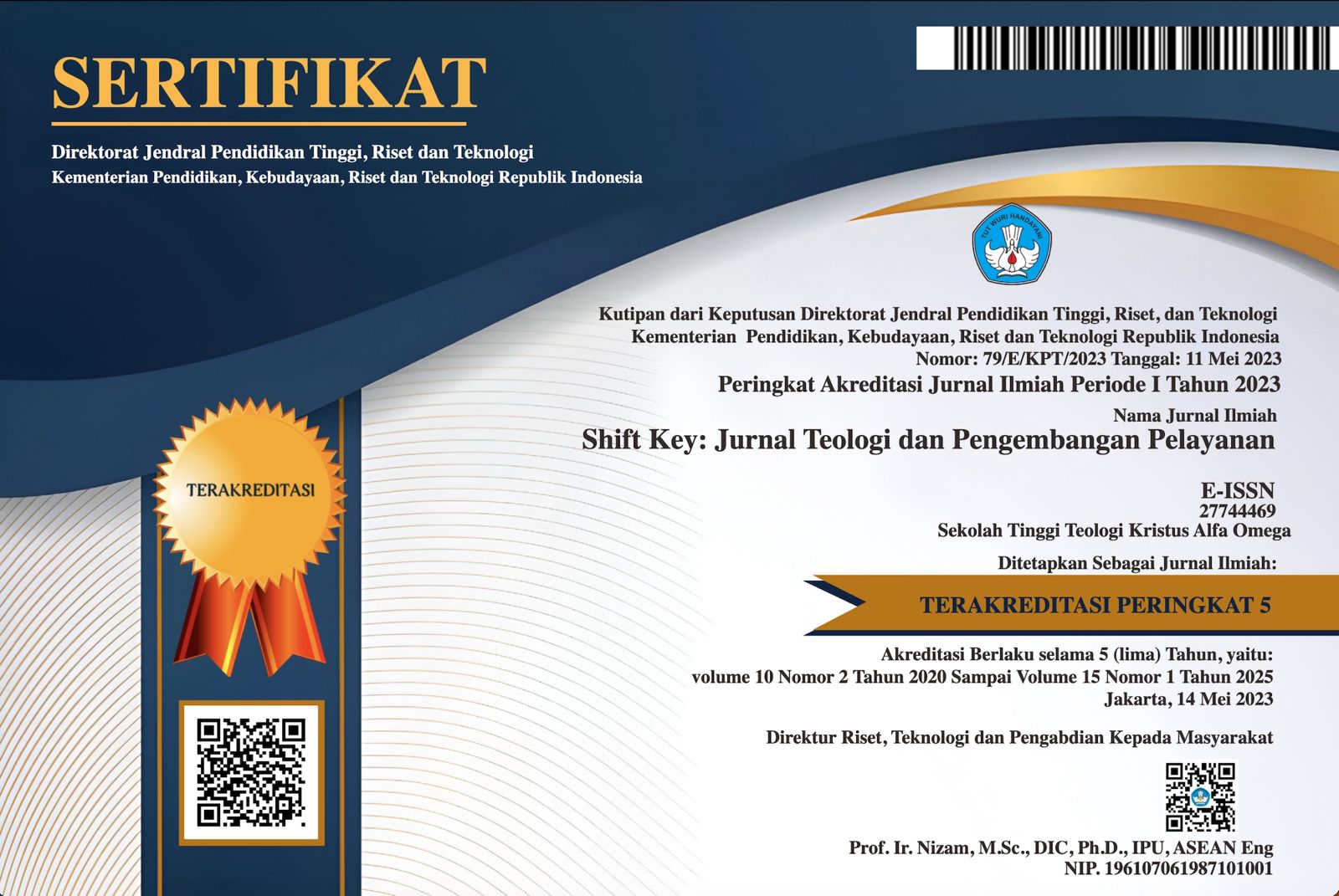Peer Review Process
There are several guidelines that should be considered during the peer review process:
- All articles submitted to Shift Key: Jurnal Teologi dan Pengembangan Pelayanan undergo a rigorous and transparent peer-review process using a double-blind review system, in which the identities of both authors and reviewers are kept confidential.
- Each manuscript is evaluated by at least two peer reviewers who possess expertise relevant to the article’s subject area and are affiliated with institutions other than the journal’s publisher.
- Before being sent to reviewers, the Editor-in-Chief and Section Editor conduct an initial evaluation (desk review) to assess the manuscript’s alignment with the journal’s focus, scope, and academic standards.
- After assignment, the Section Editor performs a pre-review refinement, providing preliminary corrections to improve the manuscript’s format, language quality, and clarity of content so that it is ready for peer evaluation.
- Reviewers assess the manuscript based on the following indicators:
- Novelty of the research or theological idea
- Academic relevance and scientific contribution
- Appropriateness of methodology and quality of analysis
- Coherence of argumentation and clarity of presentation
- Accuracy of citation and use of current references
- Reviewers provide their recommendations on the manuscript within the following categories; Accept Submission, Revisions Required, Resubmit for Review, Resubmit Elsewhere, Decline Submission.
- Authors will receive the review results through the OJS system and are required to revise their manuscripts according to the reviewers’ comments within the specified timeframe.
- After the revised manuscript is submitted, the Section Editor verifies the revisions and, if necessary, may request an additional review from the reviewers.
- The final decision on the acceptance of the article is made by the Editor-in-Chief, based on the reviewers’ evaluations and the recommendation of the Section Editor.
- Accepted articles undergo a copyediting and proofreading process to ensure accuracy in language, formatting, and adherence to the journal’s academic style guide.
- The final version of the article is published online through the OJS platform and assigned a Digital Object Identifier (DOI).
- Published articles are disseminated and indexed in academic databases such as Garuda, Crossref, Google Scholar, and Dimensions to enhance their visibility and scholarly impact.
- The journal adheres to peer review ethics based on the Committee on Publication Ethics (COPE) guidelines. Reviewers and editors are required to maintain confidentiality, act objectively, and avoid any conflict of interest during the review process.
- The estimated time for the entire publication process, from submission to publication, ranges from 8 to 12 weeks, depending on the authors’ responsiveness and the duration of the review process.
PUBLICATION PROCESS

The publication process in Shift Key: Journal of Theology and Ministry Development is carried out rigorously and transparently through the Open Journal System (OJS), following the stages below:
- Registration and Manuscript Submission (Submission Stage)
The author registers an account in the OJS system and uploads the manuscript in accordance with the journal’s template and author guidelines. Each submission must be accompanied by a statement of originality and publication ethics compliance. - Initial Evaluation by the Editor (Preliminary Evaluation)
The Editor-in-Chief evaluates the manuscript’s initial suitability with the focus and scope of the journal, administrative completeness, and potential scholarly contribution. Manuscripts that do not meet these criteria will be desk rejected, while qualified manuscripts are forwarded to the Section Editor. - Assignment of Section Editor (Editorial Assignment)
The Editor-in-Chief assigns a Section Editor according to the manuscript’s subject area to manage the editorial process. - Pre-Review Manuscript Refinement (Pre-Review Editing)
After receiving the assignment, the Section Editor conducts an initial assessment and editing to ensure that the manuscript meets the required format, structure, language quality, and clarity.
The Section Editor provides pre-review feedback to the author for technical and minor substantive corrections so that the manuscript is ready for peer review. - Reviewer Selection (Peer Reviewers Assignment)
The Section Editor appoints two or more peer reviewers from outside the publisher’s institution based on their expertise, using a double-blind review system in which both author and reviewer identities remain confidential. - Peer Review Process (Review Process)
Reviewers evaluate the manuscript in terms of novelty, academic relevance, methodological accuracy, depth of analysis, and scientific contribution. Reviewers provide recommendations as: accept as is, minor revision, major revision, or reject. - Manuscript Revision by the Author (Revision Stage)
The author revises the manuscript according to the reviewers’ comments and resubmits the revised version through the OJS platform. - Post-Review Evaluation (Revision Verification)
The Section Editor verifies the revised manuscript and may request additional review if necessary. Once the manuscript is deemed acceptable, it is forwarded to the Editor-in-Chief. - Copyediting and Proofreading (Language and Format Check)
Accepted manuscripts undergo copyediting and proofreading to ensure language accuracy, adherence to journal style, and consistency in citations and references. This process is handled by the Copyeditor and Proofreader. - Final Editing and Publication Approval (Final Editing and Approval)
The Editor-in-Chief conducts the final review of the edited manuscript to ensure content integrity, scientific quality, and compliance with publication standards before granting approval for publication. - Online Publication (Online Release)
The final version of the article is published online through the OJS platform, complete with a Digital Object Identifier (DOI), full metadata, and a Creative Commons (CC BY-SA) license. - Dissemination and Indexing (Visibility and Indexing). Published articles are disseminated and indexed through platforms such as Garuda, Crossref, Google Scholar, and Dimensions, to enhance visibility, accessibility, and scholarly impact.





